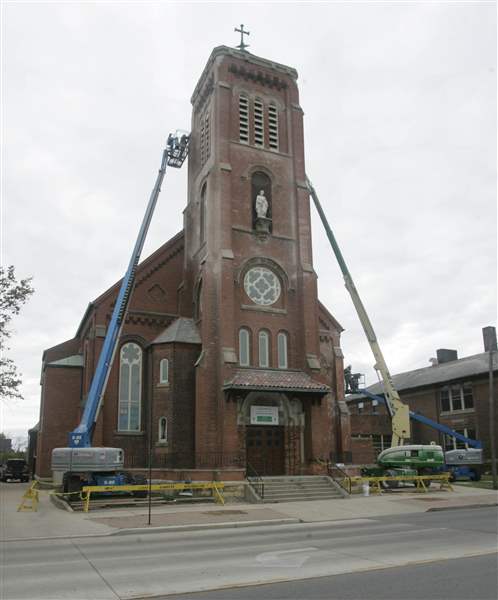
Structural work, cosmetic fixes set at St. Joseph
10/6/2010
Plans for the 122-year-old building in downtown Maumee include stained-glass restoration, improvement of the heating and air-conditioning system, roof repair, new carpeting, and construction of a new altar. Plans to raze the 108-year-old rectory require the approval of Maumee's zoning committee.
The Blade/Lori King
Buy This Image
Work began last weekend in the sanctuary on projects including refinishing of pews and kneelers, restoration of stained-glass windows, reconfiguration of the balcony, roof repairs, lighting upgrades, and constructing of a new high altar, ambo or pulpit, and baptismal font to match the original altars.
The heating and air conditioning systems will be upgraded, parking will be expanded, new carpet will be installed, exterior brick and concrete walls will be repaired, and church walls will be replastered and refinished with decorative painting that harks back to the original 1888 design.
One part of the project - razing the 108-year-old rectory - requires approval by Maumee's zoning committee. A one-story chapel to replace one in the church basement would be built on the site.
The Rev. Keith Stripe, pastor, said Thursday that the church has filed a number of zoning requests for parts of the project, but filing the paperwork on razing the rectory is "at least a year away. It's one of the last pieces."
Bruce Wholf, Maumee's building and zoning inspector, said St. Joseph "does sit within the architectural review district of the city of Maumee." Zoning applications are due the first Wednesday of each month, and public meetings are held the second Wednesday.
Once a request is filed, its fate is decided by a majority of the five-member zoning panel. A rejection can be appealed to Maumee City Council and, if the rejection is upheld, to Lucas County Common Pleas Court, Mr. Wholf said.
"As far as the city is concerned, any structure built in the early 1900s is significant," he added.

Plans for the 122-year-old building in downtown Maumee include stained-glass restoration, improvement of the heating and air-conditioning system, roof repair, new carpeting, and construction of a new altar. Plans to raze the 108-year-old rectory require the approval of Maumee's zoning committee.
John Jezak, Maumee city administrator, said he hopes the rectory can be preserved. "From a historic perspective and a community perspective, the thing to do would be to work to save it," he said. "Ultimately, what to do with it is [the church's] call, but I'd be disappointed if they decide to take it down."
Father Stripe said church leaders looked at preserving the rectory but found it was too costly and that the building, originally designed to house four priests and a housekeeper, was not suitable for office use. The church is landlocked on its property with limited building options, he added.
"There are 77 windows in that building, which gives you some perspective on how much work would be needed," he said. The roof and the heating and air conditioning system also would need extensive improvements.
"Just to fix up the building would cost $300,000, and that still does not give us a building that's accessible to all the offices, and [it is] one that doesn't function very well as far as administrative use."
Father Stripe said that in a series of meetings in September, 2009, the plans were presented to parishioners, and only 2 of the nearly 7,000 members of St. Joseph voiced a concern over demolishing the rectory.
The building program also includes adding a two-story structure to connect the church and parish school, with a room to be used primarily for funerals, a multipurpose room, more restrooms, an elevator, and a secure entrance to the school.
Jamie Orians, a member of the church's building campaign steering committee, said parishioners have been "overwhelmingly in favor" of the renovation and additions and were excited when the work began last weekend.
St. Joseph Parish, the fifth-largest in the 19-county Toledo Catholic Diocese, was founded in Maumee in 1841. The cornerstone for the brick church was laid in 1888, the rectory was built in 1902, the parish school in 1913, and the community center in 1975.
Parishioners are being asked to donate $5,000 per family or couple, or $2,500 per individual, over three years toward the building program. Father Stripe told parishioners last weekend that $2.4 million has been raised so far.
St. Joseph's announced in October, 2006, that it planned to move from Maumee and build a $20.7 million facility on 36 acres owned by the diocese on Stitt Road in Monclova Township. That project was scrapped in October, 2008, when the parish did not raise half of the funds, as required by the diocese before construction can proceed. The parish then began exploring ways to upgrade the Maumee facilities.
Father Stripe said in a letter to parishioners that the church has "no legal obligation to the property" on Stitt Road and that "it is expected the diocese will sell the property when the economic climate improves."
He said some parishioners who made donations or pledges toward the Monclova Township move canceled their pledges or asked for refunds, but most agreed to transfer their commitments to the Maumee improvements.
Contact David Yonke at:
dyonke@theblade.com
or 419-724-6154.